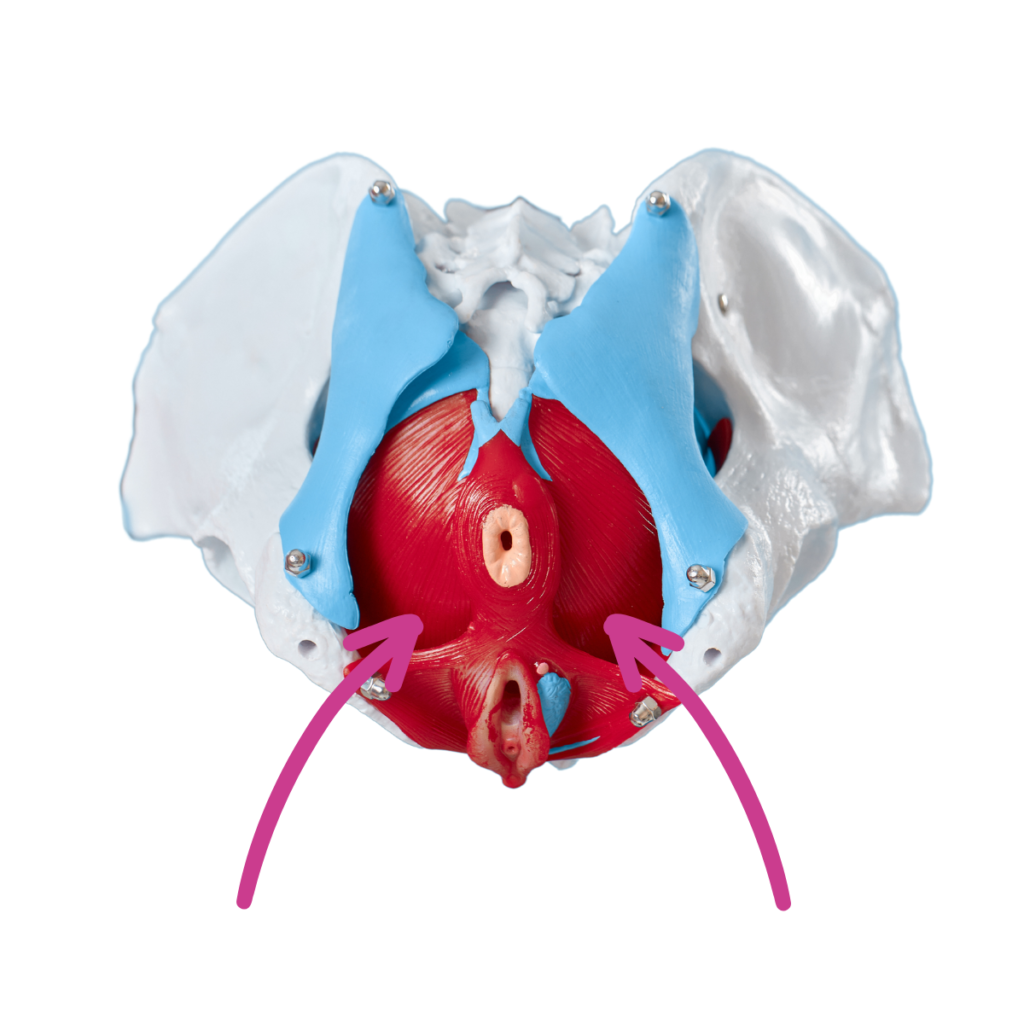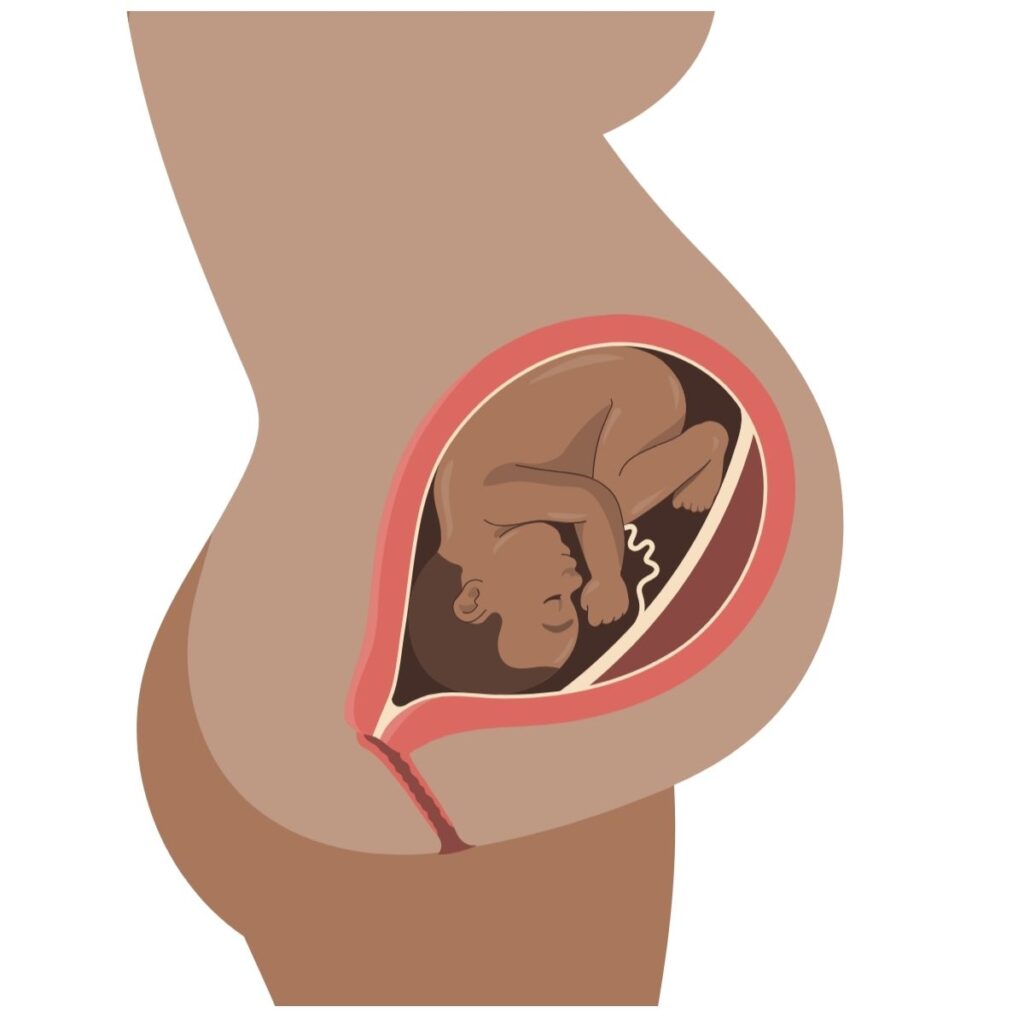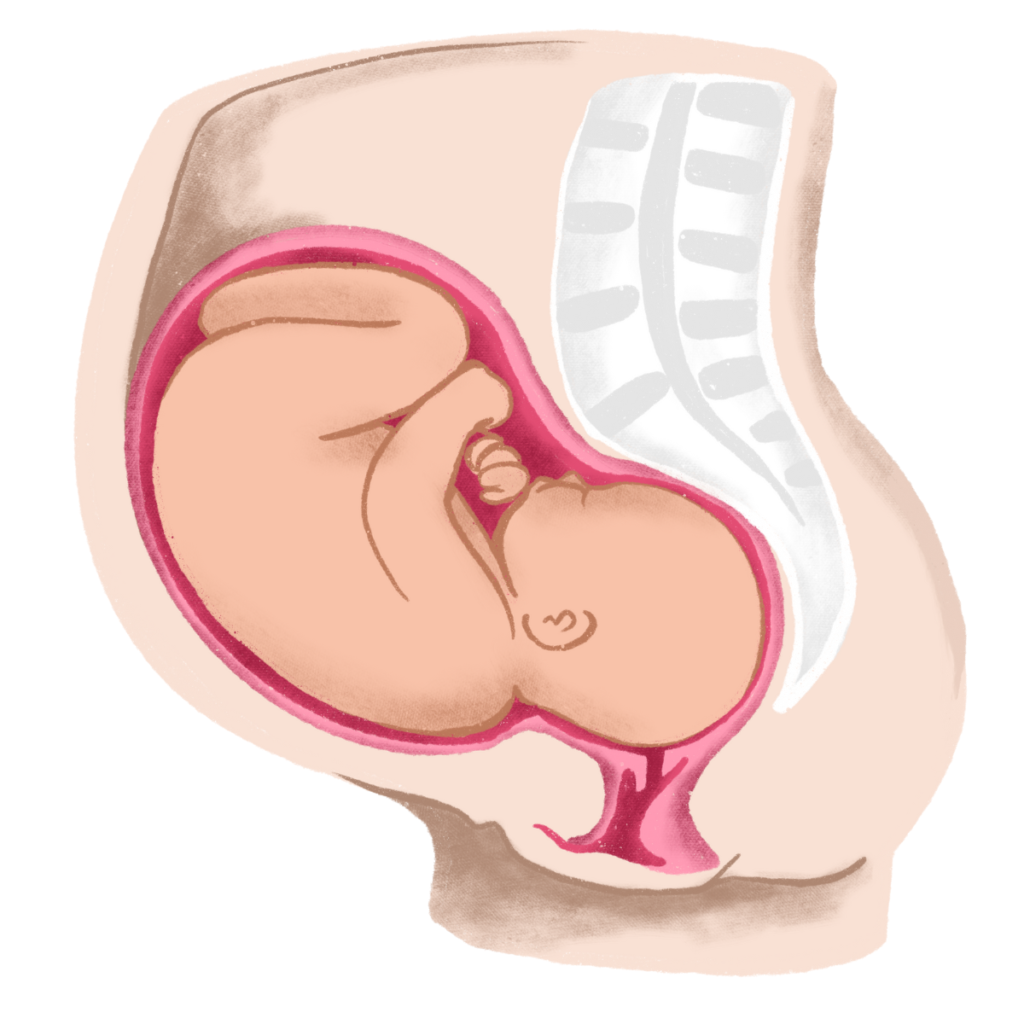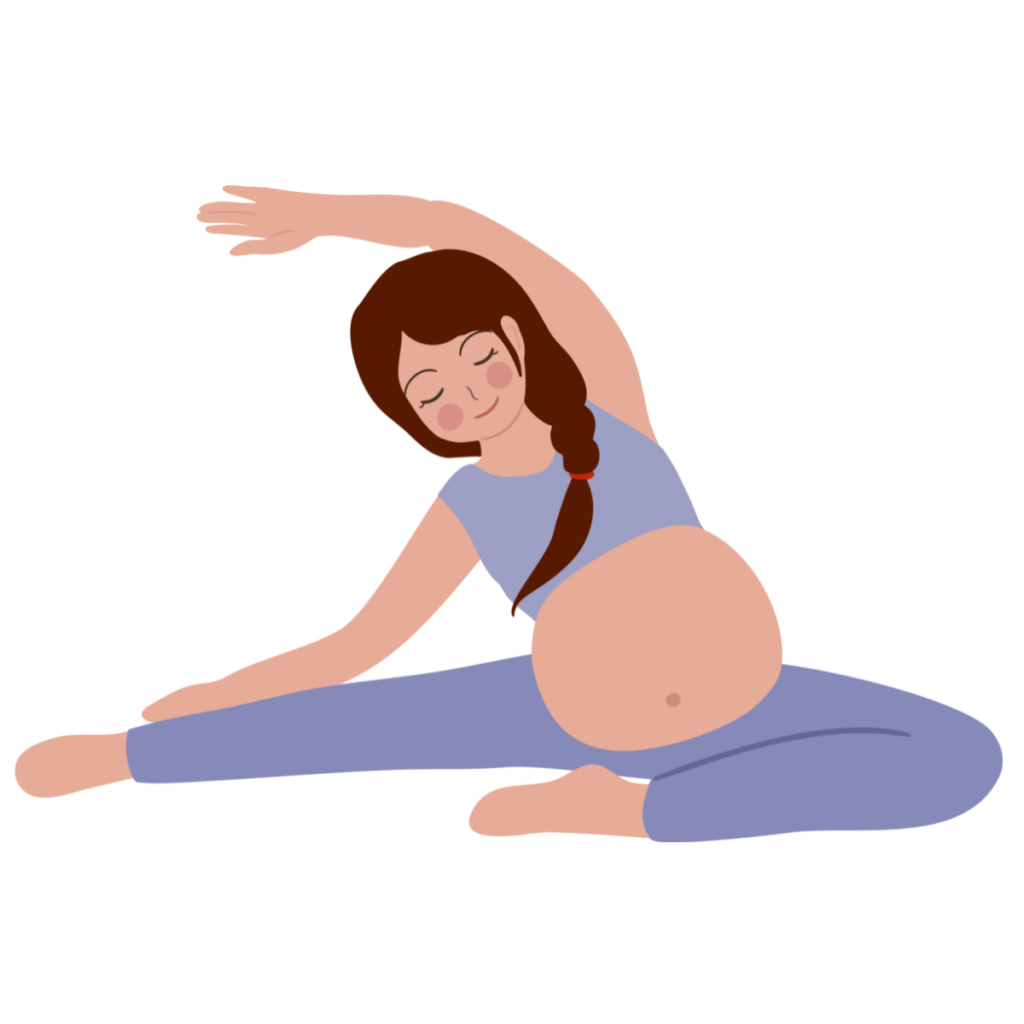What is the Pelvic Floor?

Think of the pelvic floor as a hammock or sling made up of muscles, ligaments, and tissues at the bottom of your pelvis. It serves several important functions, including:
- Support: The pelvic floor provides support for the organs in the pelvic area, including the bladder, uterus (or womb), and rectum.
- Sphincter Function: It helps control the opening and closing of the urethra, vagina, and anus, allowing for voluntary control of urination, sexual function, and bowel movements.
- Stability: The pelvic floor muscles work in conjunction with other core muscles to stabilize the pelvis and support the spine.
Understanding your pelvic floor during pregnancy is super important because it’s like the foundation for your body while your baby grows. It helps support your uterus, bladder, and bowel. Plus, getting familiar with it can help you prevent issues like leaking urine or pelvic pain, and it can even make childbirth easier. So, it’s like knowing your body’s secret superpower during pregnancy! Let’s explore the pelvic floor, why it’s important during this special time, and how you can care for it.
Anatomy of the Pelvic Floor:
The pelvic floor is stretching from the front bone of your pelvis to the tailbone at the back. There are a few important parts:
- Pelvic Diaphragm: This is the main muscle layer of the pelvic floor. It includes different muscles like the pubococcygeus, puborectalis, and iliococcygeus. These muscles help support your pelvic organs, like your bladder and uterus, and keep you continent (meaning you can control when you go to the bathroom).
- Perineal Body: This is a strong structure between the vagina and anus. It’s like a central point where many pelvic floor muscles attach. It helps support the pelvic floor and keeps everything in place.
- Pelvic Organs: Your pelvic floor does an important job holding up your bladder, uterus (or womb), and rectum. It’s like a strong foundation that keeps these organs where they should be.
All these parts work together to support your body and keep things running smoothly.

What happens during pregnancy?
During pregnancy, your pelvic floor works overtime! It provides essential support for your growing baby and uterus. As your baby grows, your pelvic floor stretches and adapts to accommodate the extra weight. The growing fetus exerts increasing pressure on the pelvic floor as the pregnancy progresses. This can lead to stretching and weakening of the pelvic floor muscles and may contribute to symptoms such as urinary incontinence and pelvic discomfort.

Understanding how pregnancy changes your Pelvic Floor
Pregnancy is a remarkable journey filled with countless changes, both big and small, in your body. One area that undergoes significant transformation during this time is your pelvic floor. Let’s take a closer look at how pregnancy affects your pelvic floor and what you can do to support its health.
- Hormonal Fluctuations: Hormonal changes are a pregnancy hallmark and impact the pelvic floor.
- Muscle Relaxation: In addition to hormonal changes, the pelvic floor muscles may relax in response to increased pressure and stretching. While relaxation is necessary for childbirth, excessive relaxation or weakness in the pelvic floor muscles can contribute to pelvic floor dysfunction, such as urinary incontinence or pelvic organ prolapse.
- Increased Pressure: As your baby grows inside your uterus, it puts pressure on your pelvic floor muscles and tissues. This pressure gradually increases, causing your pelvic floor to stretch and weaken. Additionally, the weight of your growing baby can compress pelvic structures, leading to changes in pelvic floor function and sensation.
- Uterine Expansion: Your uterus undergoes significant expansion during pregnancy to accommodate your growing fetus. As it expands, it displaces other pelvic organs and increases pressure on your pelvic floor. This expansion can result in pelvic floor tone and function changes, affecting urinary, bowel, and sexual health.
- Postural Adjustments: Pregnancy alters a woman’s posture and the alignment of her pelvis as her body adjusts to accommodate the growing baby. As the center of gravity shifts forward and abdominal muscles stretch to accommodate the expanding uterus, the pelvic floor muscles may become overstretched or weakened. These postural changes can impact pelvic floor function and contribute to discomfort or pelvic floor dysfunction.

How the pelvic floor can adapt to all those changes?
The pelvic floor is a remarkably adaptable and resilient part of the body that undergoes significant changes during pregnancy. Despite the challenges it faces, the pelvic floor has mechanisms in place to adapt to these changes and support the growing baby.
- Muscle Strength and Tone: Pelvic floor muscles can strengthen and maintain tone, even in the face of increased pressure and hormonal changes.
- Flexibility and Elasticity: Just as muscles in other parts of the body can stretch and contract, pelvic floor muscles possess elasticity that allows them to stretch and adapt to the expanding uterus and growing baby.
- Neuromuscular Control: The pelvic floor is innervated by a complex network of nerves that regulate muscle function and sensation. During pregnancy, the nervous system adapts to accommodate the increased demands placed on the pelvic floor, enhancing neuromuscular control and coordination.
- Recovery and Rehabilitation: Following childbirth, the pelvic floor has the remarkable ability to recover and regain strength and function.
How do hormones affect the pelvic floor during pregnancy?
The incredible thing is that despite the significant changes and pressures our pelvic floor undergoes, our body is perfectly designed to support these muscles, with hormones playing a crucial role. Let’s explore how hormones have a significant impact on this. Hormones are mostly behind everything related to pregnancy what would we do without them!!
The secretion of hormones during pregnancy varies throughout the gestational period and is orchestrated by the changing needs of both the mother and the developing fetus. Here’s a general overview of the key hormones involved in preparing the pelvic floor for childbirth.
Relaxin: Relaxin plays a significant role in preparing the body for childbirth. It acts on the pelvic ligaments and tissues, including those of the pelvic floor, to promote relaxation and flexibility. Relaxin helps soften and loosen the ligaments and muscles of the pelvic floor, allowing them to stretch and accommodate the passage of the baby through the birth canal during labor. Peak levels of relaxin are typically reached in the third trimester, particularly in the weeks leading up to childbirth.
Progesterone: It plays a crucial role in maintaining the uterine environment and supporting the growth and development of the fetus. Progesterone also contributes to the relaxation of smooth muscle tissue throughout the body, including the muscles of the pelvic floor. By promoting muscle relaxation, progesterone helps prepare the pelvic floor for the stretching and expansion that occurs during childbirth. Progesterone levels rise steadily throughout pregnancy, beginning soon after conception and reaching their peak in the second trimester.


Oxytocin: Oxytocin stimulates uterine contractions, which help progress labor and facilitate birth. Additionally, oxytocin promotes the relaxation of the pelvic floor muscles between contractions, allowing for optimal stretching and passage of the baby through the birth canal.
Endorphins: Endorphins are natural pain-relieving hormones produced by the body, particularly during times of stress or pain, such as childbirth. Endorphins help alleviate discomfort and promote relaxation during labor. By reducing pain and promoting relaxation, endorphins indirectly contribute to the relaxation of the pelvic floor muscles, allowing them to stretch and accommodate the birthing process. Endorphin levels rise during labor and peak during the intense contractions of active labor.
These hormones work together to prepare the pelvic floor for childbirth by promoting relaxation, flexibility, and efficient uterine contractions. Relaxin and progesterone help soften and loosen the pelvic floor muscles and ligaments, while oxytocin and endorphins facilitate uterine contractions and promote relaxation during labor. This hormonal interplay is essential for ensuring a smooth and successful childbirth experience.

What can we do to support and have a healthy pelvic floor during pregnancy?
Pelvic Floor Exercises: Incorporate pelvic floor exercises, such as Kegels, into your daily routine to strengthen these muscles. Kegel exercises are a series of contractions and relaxations of the pelvic floor muscles. These exercises specifically target the muscles that support the pelvic organs, including the bladder, uterus, and rectum. Strengthening the pelvic floor muscles during pregnancy can
- Prevent or reduce urinary incontinence caused by bladder pressure.
- Provide better support for the growing uterus, reducing the risk of pelvic organ prolapse.
- Aid in childbirth by improving muscle control and coordination during labor.
Kegels exercises:
How to Perform Kegels:
- Identify the muscles: Begin by identifying the pelvic floor muscles. You can do this by stopping the flow of urine midstream or by imagining that you’re trying to stop passing gas.
- Once you’ve identified the pelvic floor muscles, contract them by squeezing and lifting upward. Hold the contraction for a few seconds, then release and relax the muscles.
- Aim for 10-15 repetitions of Kegel exercises, holding each contraction for 5-10 seconds, several times a day.
- Remember to breathe normally while performing Kegels. Avoid holding your breath or tensing other muscles in your body.
- Start with a comfortable number of repetitions and gradually increase the duration and intensity of the contractions as your pelvic floor muscles become stronger.
Good posture:
Maintain Good Posture: Good posture helps distribute weight evenly throughout the body, reducing excessive pressure on the pelvic floor muscles.
Tips for Good Posture:
- Spinal Alignment: Stand or sit with your spine in a neutral position, avoiding excessive arching or rounding of the back. Engage your core muscles to support the spine and pelvis.
- Pelvic Alignment: Align your pelvis so that it is neither tilted too far forward nor too far backward. Imagine balancing a bowl of water on your pelvis to find a neutral position.
- Shoulder Position: Roll your shoulders back and down, opening up the chest and preventing slouching.
- Head Position: Keep your head aligned with your spine, avoiding excessive forward or backward tilting.
- Weight Distribution: When sitting, distribute your weight evenly on both hips, and avoid crossing your legs for prolonged periods.
Avoiding Prolonged Static Positions: Prolonged periods of sitting or standing in one position can lead to muscle fatigue and strain on the pelvic floor. Aim to change positions frequently throughout the day to reduce pressure on the pelvic floor muscles.
Using Supportive Pillows: Supportive pillows or cushions can help maintain proper alignment and reduce pressure on the pelvic floor when sitting or lying down. Use a small cushion or rolled towel to support the lower back when sitting, or place a pillow between your knees when lying on your side to align the hips and pelvis.
Engaging in Pelvic Floor Awareness: Practicing pelvic floor awareness exercises, such as pelvic tilts and gentle contractions, can help strengthen and support the pelvic floor muscles while maintaining good posture.


More and more tips!
Stay Active: Engage in regular physical activity, such as walking, swimming, or prenatal yoga, to promote circulation and muscle tone throughout your body, including the pelvic floor. Practicing prenatal yoga or gentle stretching exercises can help release tension in the pelvic floor and surrounding muscles. Focus on poses that gently stretch the hips, groin, and pelvic area. Always listen to your body and avoid overstretching.
Stay Hydrated and Eat a Balanced Diet: Drink plenty of water to stay hydrated and maintain healthy bladder function. Eat a balanced diet rich in fiber to prevent constipation, which can strain the pelvic floor muscles.
Avoid Heavy Lifting: Minimize heavy lifting or strenuous activities that place excessive pressure on the pelvic floor muscles. Use proper lifting techniques and ask for help when needed.
Perineal Massage: Perineal massage involves gently massaging the tissues between the vagina and anus to help increase flexibility and reduce the risk of tearing during childbirth. You can start perineal massage around 34 weeks of pregnancy. Use a lubricant such as vitamin E oil or olive oil, and insert your thumbs into the vagina about an inch and gently massage in a U-shaped motion for a few minutes each day. Please consult your healthcare provider before engaging in perineal massage. They can explain the correct technique and determine if it’s suitable for you based on your individual health needs and circumstances.
Deep Breathing: Deep breathing exercises can help relax the pelvic floor muscles and reduce tension. Practice deep, diaphragmatic breathing by inhaling deeply through your nose, allowing your abdomen to expand, and then exhaling fully through your mouth, allowing your abdomen to contract. Focus on relaxing your pelvic floor muscles with each breath.
Postpartum pelvic floor care
Caring for the pelvic floor postnatally is essential for supporting recovery and maintaining pelvic health after childbirth. Here are some key considerations:
Pelvic Floor Exercises: Start pelvic floor exercises as advised by your healthcare provider to strengthen muscles and aid recovery.
Gradual Activity: Ease back into physical activity, avoiding high-impact exercises initially.
Maintain Good Posture: Support the pelvic floor by practicing good posture and avoiding prolonged sitting or standing.

Healthy Habits: Stay hydrated, eat a balanced diet, and avoid heavy lifting to aid healing.
Listen to Your Body: Pay attention to your body’s signals and seek help if you experience persistent symptoms or concerns.

When should I seek assistance?
If you are concerned about anything, your healthcare provider is always there for you. It’s essential to seek assistance for any problems related to the pelvic floor if you experience persistent symptoms or concerns that impact your quality of life. Here are some signs indicating when to seek assistance:
- Urinary or bowel incontinence
- Pelvic pain or discomfort
- Pelvic organ prolapse symptoms
- Difficulty emptying bladder or bowel
- Postpartum pelvic floor problems
- Sexual dysfunction
Remember, your body is wise, and most of the time, it’s perfectly equipped to adapt to the demands of pregnancy and childbirth. But if things don’t go as planned, healthcare providers are always there to support you. Your well-being is our priority.
